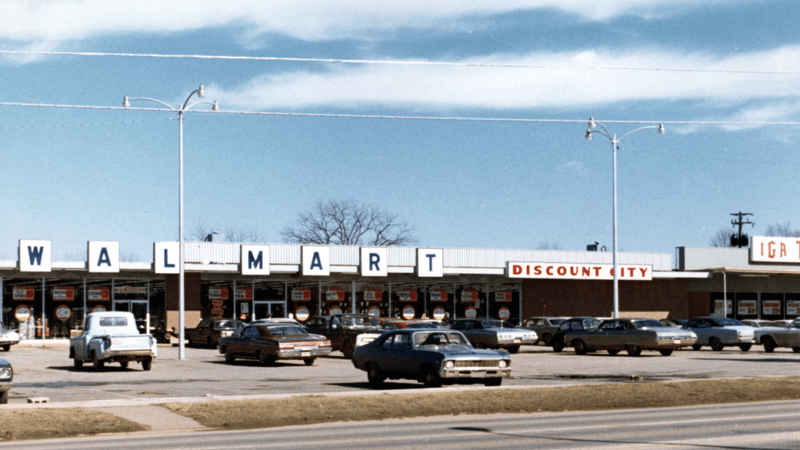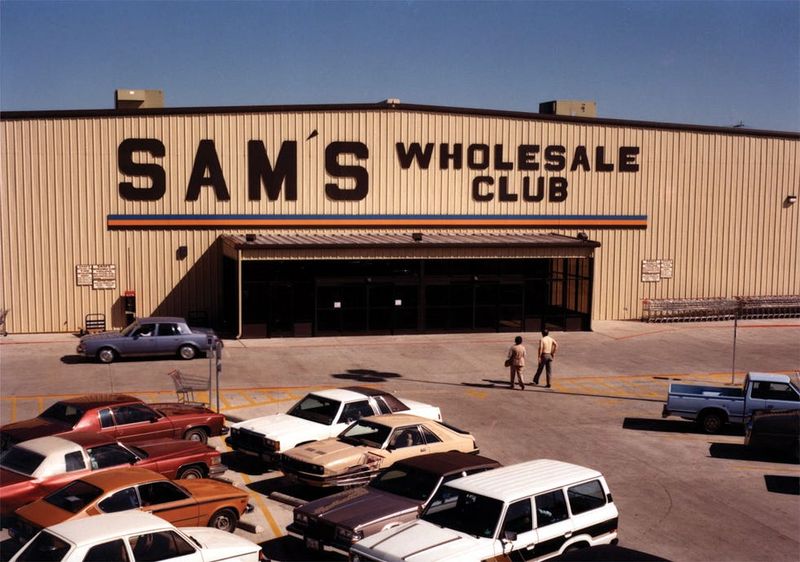Walmart’s journey from a single store to a global retail giant is one of America’s most amazing business stories. Started by Sam Walton in the 1960s, this company changed how people shop by making everyday items cheaper for regular folks.
The photos of Walmart’s growth over the years show not just how stores look different, but how shopping itself has changed for millions of people around the world.
1. The Humble Beginnings: Walton’s 5&10 (1950)
Sam and Helen Walton’s modest variety store in Bentonville, Arkansas marked the starting point of a retail revolution. The couple invested $25,000 to open their dream shop, selling everything from toys to household goods at bargain prices.
Locals quickly embraced the store’s friendly atmosphere and value-focused approach. Sam would personally greet customers at the door, learning their names and preferences.
Today, this historic building houses The Walmart Museum, preserving vintage merchandise, Sam’s old pickup truck, and the original store’s cash register. Visitors can even enjoy ice cream at the functioning soda fountain while experiencing a slice of American retail history.
2. The First Walmart Store Opens (1962)
July 2, 1962 marked retail history when Sam Walton unveiled the first official Walmart Discount City in Rogers, Arkansas. Unlike traditional retailers who marked up products 45%, Walton implemented a revolutionary 30% markup strategy, immediately attracting budget-conscious shoppers.
The no-frills store featured fluorescent lighting, concrete floors, and merchandise stacked high on metal shelves. Customers could find everything from clothing to hardware at prices that seemed almost too good to be true.
Sam’s business philosophy was simple yet powerful: sell products at the lowest possible prices to boost sales volume. This strategy would eventually transform American retail forever.
3. Going Public: A Financial Milestone (1970)
Money talks! Walmart’s 1970 decision to list on the New York Stock Exchange forever altered its trajectory. Those lucky enough to purchase 100 shares at the initial $16.50 price have since watched that investment multiply exponentially through stock splits and growth.
The influx of capital enabled Sam Walton to accelerate store openings across rural America, areas often overlooked by larger retailers. By the end of the decade, Walmart operated 276 stores across 11 states.
Fascinating fact: Despite becoming a billionaire through Walmart’s success, Sam Walton continued driving his famous red pickup truck and maintained his humble lifestyle, embodying the company’s frugal values even as it achieved unprecedented financial success.
4. The Introduction of Sam’s Club (1983)
Warehouse shopping revolutionized retail when Walmart launched Sam’s Club in Midwest City, Oklahoma. Named after the company’s founder, these massive stores catered to small business owners seeking bulk purchases at wholesale prices.
The warehouse concept stripped away frills – concrete floors, visible ductwork, and merchandise displayed on industrial shelving or pallets. Members paid annual fees for access to everything from giant cereal boxes to office equipment at dramatically reduced prices.
Sam’s Club quickly became the perfect complement to Walmart’s regular stores. While competitors like Price Club (later Costco) pioneered the warehouse model, Walmart’s distribution network and purchasing power helped Sam’s Club rapidly expand nationwide, creating a new shopping category for value-hungry Americans.
5. The First Walmart Supercenter (1988)
Retail innovation reached new heights when Walmart unveiled its first Supercenter in Washington, Missouri. This revolutionary 220,000-square-foot shopping mecca combined traditional Walmart merchandise with a full grocery store, creating a true one-stop shopping destination.
Shoppers marveled at departments ranging from automotive to fresh produce, all under one massive roof. The Supercenter concept eliminated separate trips to grocery stores, pharmacies, and department stores, saving families precious time and money.
Competitors initially scoffed at the idea of selling milk alongside motor oil. However, the Supercenter format proved so successful that it became Walmart’s dominant store model, transforming American shopping habits and forcing competitors to adapt or perish.
6. International Expansion Begins (1991)
¡Bienvenido a Walmart! The retail giant planted its international flag in 1991 by partnering with Mexican retail conglomerate Cifra to open a Sam’s Club in Mexico City. This strategic move marked Walmart’s first step beyond U.S. borders and the beginning of its global ambitions.
Cultural adaptations proved crucial for success. Mexican stores featured larger produce sections, in-store tortillerias, and merchandise tailored to local preferences rather than simply replicating American stores.
The Mexico experiment provided valuable lessons for Walmart’s subsequent expansion into diverse markets. Throughout the 1990s, the company established footholds in Canada, China, the United Kingdom, and beyond, adapting its famous “everyday low prices” philosophy to different shopping cultures around the world.
7. Embracing Technology and E-Commerce (2000s)
Y2K ushered in Walmart’s digital revolution! As internet shopping gained momentum, the retail giant launched Walmart.com, determined not to be left behind in the e-commerce boom. Behind the scenes, the company invested billions in cutting-edge inventory systems that tracked products from factory to shelf with unprecedented precision.
RFID tags, automated distribution centers, and sophisticated data analytics transformed Walmart’s already legendary supply chain efficiency. Store managers received handheld devices that provided real-time inventory information, eliminating the guesswork in restocking decisions.
The technological metamorphosis wasn’t always smooth sailing. Early website iterations faced criticism, and Amazon’s rapid growth posed serious challenges. However, these digital investments positioned Walmart to eventually become a formidable online competitor while maintaining its brick-and-mortar dominance.
8. Commitment to Sustainability (2005)
Green became Walmart’s favorite color in 2005 when CEO Lee Scott stunned the business world by announcing ambitious environmental goals. The retail behemoth pledged to create zero waste, use 100% renewable energy, and sell sustainable products – commitments that skeptics initially dismissed as impossible for a company of Walmart’s size.
Solar panels began appearing on store rooftops. Trucks were redesigned to improve fuel efficiency by 25%. Even store lighting switched to energy-saving LEDs, saving millions in electricity costs.
The sustainability push wasn’t purely altruistic – these initiatives saved Walmart billions while burnishing its corporate image. Nevertheless, the company’s massive scale meant that even incremental improvements had significant environmental impacts, proving that profitability and sustainability could coexist in modern retail.
9. Modernization and Rebranding (2008)
Out with the boxy star, in with the sunny spark! Walmart’s 2008 logo makeover replaced its angular, all-caps signature with a friendlier lowercase wordmark and cheerful yellow sunburst. This visual transformation symbolized the company’s efforts to shed its utilitarian image and appeal to more affluent shoppers.
Store interiors received equally dramatic makeovers. Harsh fluorescent lighting gave way to natural illumination, concrete floors were covered with polished tiles, and cluttered aisles became more navigable. Even product selection evolved to include organic foods, designer collaborations, and premium electronics.
The rebranding coincided with the “Save Money. Live Better.” slogan that replaced the decades-old “Always Low Prices.” This subtle shift emphasized value beyond mere cheapness – a strategic repositioning as competitors like Target gained market share among style-conscious consumers.
10. Walmart Today: A Global Retail Leader
From Arkansas to the world! Modern Walmart operates over 10,500 stores across 24 countries, employing 2.3 million associates who serve nearly 240 million customers weekly. The company’s annual revenue exceeds half a trillion dollars – more than the GDP of many countries.
Today’s stores barely resemble their predecessors. Shoppers use smartphone apps to navigate aisles, self-checkout kiosks replace traditional cashiers, and curbside pickup allows customers to shop without entering stores. Walmart+ subscription service directly challenges Amazon Prime with free delivery and member perks.
Despite its massive digital transformation, Walmart’s core philosophy remains remarkably consistent with Sam Walton’s original vision: helping people save money so they can live better. This enduring mission has sustained the company through economic upheavals, technological revolutions, and changing consumer preferences.










